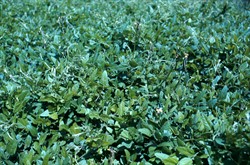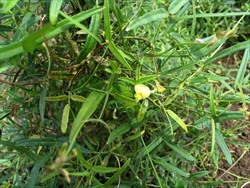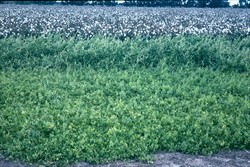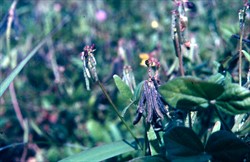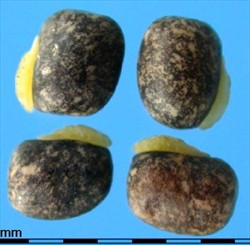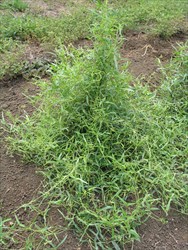Vigna oblongifolia
Tropical Forages
Vigna oblongifolia A. Rich.
Subordinate taxa:
Vigna oblongifolia A. Rich. var. oblongifolia
Vigna oblongifolia A. Rich. var. parviflora (Welw. ex Baker) Verdc.
var. oblongifolia: Vigna lancifolia A. Rich.; Vigna wilmsii Burtt Davy
var. parviflora: Basionym: Vigna parviflora Welw. ex Baker
Family: Fabaceae (alt. Leguminosae) subfamily: Faboideae tribe: Phaseoleae subtribe: Phaseolinae subgenus: Vigna.
A variable annual or short-lived perennial species with trailing or weakly twining (rarely semi-erect) habit, to 0.8 m high; stems slender, slightly tawny-bristly, 1-5 m long. Leaves trifoliolate; petiole 4–5 cm long, thinly bristly; leaflets linear-lanceolate or ovate, apex acute or rounded, base cuneate or rounded, not lobed, venation reticulate, 15–120 × 2–5 mm, pubescent, hairs sparse, shorter than 1 mm, pale yellow-brown, upper surface sometimes glabrous; stipules linear-lanceolate or ovate, erect, basifixed, base produced, and cordate, 2–4 × 0.8–5 mm, lower extension 0.5–1.0 mm. Inflorescence an auxiliary raceme comprising 2–10 yellow or greenish-yellow flowers on a somewhat zigzag rachis 0.5–2.5 cm long on hairy peduncle 2–35 cm long; swollen glands at bases of pedicels. Flower 6–12 mm, pedicel 2–5 mm; bracteoles deciduous, lanceolate, shorter than calyx, densely hairy; calyx tube 1–2.5 mm, teeth 1–4 mm, lower tooth longer, tube and teeth approximately equal, upper teeth fused, tube sparsely hairy or densely hairy, hairs pale yellow-brown; standard glabrous; keel beaked, not curved, pocket absent. Pods hanging downwards, linear cylindrical, 17–70 × 2.5–5 mm, compressed, slightly constricted between the seeds, covered with adpressed, reddish-brown/white hairs, 3–9-seeded. Seeds greenish, brown or dark reddish-brown, often mottled with black; irregularly oblong, ovoid or sub-globose, 2–4.5 mm long, 2–3.2 mm wide, and 1.5–2.2 mm thick; aril eccentric. 30,000–110,000 seeds per kg.
var. oblongifolia: leaflets ovate, oblong-lanceolate to lanceolate, to 12 cm long, 2.2 cm wide. Calyx tube 1.5–2.5 mm, teeth 1.5–2.5 mm; standard 10–11 mm long. Pod 4–7 cm long; seed c. 4.0 × 3.0–3.5 mm.
var. parviflora: leaflets ovate to linear-lanceolate, 1.5–8 cm long, 0.2–2.5 cm wide. Calyx tube 1.0–1.5 mm, teeth 1.0–1.5 mm; standard 6–8 mm long. Pod 2.3–4 cm long; seed 2.5–3.0 × 2.0–2.5 mm.
Africa: wáákén kwaďi (Hausa, Nigeria), wáákén kada, waken kada (var. oblongifolia, Hausa, Nigeria), ginceregi (Nupe, Nigeria); kalalalonde (var. oblongifolia, Tanzania); lotomba (var. oblongifolia, DRC); kashilishili (var. parviflora, Tanzania); siboyani (var. parviflora, Lozi, Zambia)
English: oblong-leaved bean; common oblong-leaved bean (var. oblongifolia); small-flowered bean (var. parviflora)
var. oblongifolia
Native:
Africa: Botswana; Burundi; Cameroon; Democratic Republic of the Congo; Eritrea; Ethiopia; Kenya; Malawi; Nigeria (n.); South Africa (Natal, Transvaal); Sudan; Tanzania; Zambia; Zimbabwe
var. parviflora
Native:
Africa: Angola; Botswana; Burundi; Cameroon; Democratic Republic of the Congo; Ethiopia; Rwanda; Kenya; Nigeria; Malawi; South Africa; Tanzania; Uganda; Zambia; Zimbabwe
Indian Ocean: Madagascar
Forage
Pioneer and self-regenerating annual in permanent pasture and for short-term pasture leys.
Soil requirements
Found on clays, clay loams, loams and sands with pH of 5.2‒7.4, and has been successfully cultivated on light and heavy clays with pH up to 8.5.
Moisture
Collected from areas with rainfall ranging from 350 to 1,200 mm/yr, largely from areas of impeded drainage, high water table and swamp, but also from well-drained soils. In cultivation, it has failed to persist in well-drained, low rainfall environments but has persisted and spread in more humid environments.
Temperature
V. oblongifolia extends from about 29º S in South Africa to north of the Equator in Ethiopia, and from 300 to 1,900 m asl. Average annual temperatures at collection sites range from about 17 to 23 ºC, experiencing frosts in the higher latitudes. Annuals are killed by frost and therefore need to set seed early in order to regenerate.
Light
Found growing in thickets and woodlands suggesting at least moderate shade tolerance.
Reproductive development
Accessions tested appear to be short day plants, commencing flowering in March/April at about 26º S, with some variation between accessions.
Defoliation
Requires rotational grazing to allow for regrowth and seed set. Little regrowth if cut back once mature. Accessions of V. oblongifolia have persisted and spread under regular grazing in coastal southern Queensland.
Fire
For persistence, annuals in fire-prone areas must set seed before the advent of fire. However, seed of many legumes is scarified by a moderate fire, resulting in enhanced populations.
Guidelines for establishment and management of sown forages.
Establishment
Seed of V. oblongifolia can have quite a high level of hard seed. Most scarification pretreatments will reduce hard seed content and improve germination percentage and germination rate when compared to untreated seeds. Treating seed with concentrated sulfuric acid for 15 min before washing thoroughly in running water is an effective treatment for small seedlots. Although this species appears promiscuous in its rhizobium requirements, inoculation with a cowpea strain such as CB1015 or CB756 may be advantageous. Seed is sown at 3‒5 kg/ha into a well-prepared seedbed.
Fertilizer
As with many other Vigna spp., V. oblongifolia will probably respond to P on soils low in this nutrient.
Compatibility (with other species)
Competes effectively with even sward grasses and other legumes when sown together, but does not regenerate very successfully in competition with perennial grasses in sub-humid environments.
Companion species
Grasses: Axonopus fissifolius, Chloris gayana, Digitaria eriantha (pangola), Paspalum atratum, P. dilatatum, P. plicatulum, Setaria sphacelata.
Legumes: Aeschynomene americana, Aeschynomene villosa, Arachis pintoi, Grona heterocarpa subsp. heterocarpa, Macroptilium lathyroides, Vigna parkeri.
Pests and diseases
Leaves often have scattered to dense perforations caused by leaf-eating insects, although this rarely constitutes a serious problem. Pods are not attacked to any extent by the legume pod borer (Maruca vitrata) and pod sucking bugs (Clavigralla tomentosicollis, Anoplocnemis curvipes and Riptortus dentipes) all of which cause significant damage in cowpea (Vigna unguiculata). The legume pod borer and pod sucking bugs can cause tremendous grain-yield losses in cowpea if appropriate control measures are not taken. At least moderate resistance to cowpea weevil, Callosobruchus maculatus.
Ability to spread
V. oblongifolia has significant capacity to spread, providing the defoliation pressure is fairly low. Pods shatter violently, flicking seed some distance from the parent plant, and seed is also spread through ingestion by the grazing animal.
Weed potential
Although it can spread, it is insufficiently aggressive and too palatable to livestock to pose a significant weed threat.
Nutritive value
23.7% CP content at full flowering, and 17.2‒18.8% CP at late flowering. CF 24‒28%, NFE 39‒48%, Ca 0.96‒1.25%, and P 0.25‒0.37%.
Palatability/acceptability
Highly palatable.
Toxicity
No record of toxicity in this or other Vigna spp.
Dry matter
Produces from 2 to 6 t/ha/yr DM.
Animal production
No information available.
2n = 22. Among the non-cultivated African Vigna species, there have been successful crosses between V. oblongifolia and two others, V. ambacensis and V. luteola, all three belonging to section Vigna of the subgenus Vigna. Although the hybrids are only partially fertile, embryo rescue has been used to recover an F1 interspecific hybrid between V. oblongifolia and V. luteola.
V. oblongifolia is a prolific seed producer. Var. parviflora flowers for much of the growing season, while var. oblongifolia appears to have a more limited flowering period.
No information available, but probable tolerances and susceptibilities similar to the closely related Vigna luteola:
"Imazethapyr can be used as pre-sowing/pre-emergent, post-sowing/pre-emergent or post-emergent herbicide (first or second trifoliolate leaf). Pre-emergent application may have some effect on germination and post-emergent application may have some slight effect on seedlings, although this is often short-term. Metolachlor and trifluralin can also be used as pre-emergent applications, but not atrazine or metribuzin. Acifluorfen, bentazone and flumetsulam appear safe as post-emergent sprays, but not 2,4-D, 2,4-DB, picloram, fluroxypur (fluroxypyr), or chlorsulfuron. Glyphosate can be used post- sowing/pre-emergent to control weeds at planting; it has also been used at low application rate on mature plants to control emerging weeds."
- Easily established in cultivated, weed-free seedbeds.
- Very palatable.
- Tolerant of poor drainage.
- Low to moderate productivity.
Clem, R.L., Brandon, N.J., Conway, M.J., Esdale, C.R. and Jones, R.M. (2001) Early stage evaluation of tropical legumes on clay soils at three sites in central and southern inland Queensland. Technical Memorandum No 7. CSIRO Tropical Agriculture, St Lucia, Australia.
Gillett, J.B., Polhill, R.M. and Verdcourt, B. (1971) Papilionoideae (Part 2). In: Milne-Redhead, E. and Polhill, R.M. (eds) Flora of Tropical East Africa. Crown Agents for Overseas Governments and Administrations, London, UK. p. 629–630.
Hacker, J.B., Williams, R.J. and Pengelly, B.C. (1996) A characterisation study of the genus Vigna with regards to potential as forage. Genetic Resources Communication No. 22. CSIRO Tropical Agriculture, St Lucia, Australia. bit.ly/39GfIIi
Jones, R.M. (1998) Evaluation of a range of tropical legumes on two clay soils in south east inland Queensland. Technical Memorandum No. 2. CSIRO Tropical Agriculture, St Lucia, Australia.
Jones, R.M. (2001) Evaluation of legumes and grasses in coastal south-east Queensland. Tropical Grasslands 35:85–95. bit.ly/2UDlllf
Maxted, N., Mabuza-Diamini, P., Moss, H., Padulosi, S., Jarvis, A. and Guarino, L. (2004) An ecogeographic study African vigna. Systematic and ecogeographic studies on crop genepools No. 11. IPGRI, Rome, Italy. hdl.handle.net/10568/105017
Pengelly, B.C. and Conway, M.J. (1998) The evaluation of tropical legumes for use in ley pastures in central and southern Queensland. Proceedings of the 9th Australian Agronomy Conference, Wagga Wagga, NSW, Australia, 20-23 July 1998. p. 163–166. bit.ly/2WVSzPI
van Rensburg, H.J. (1967) Pasture Legumes and Grasses in Zambia. Govt. Printer, Lusaka, Zambia.
Wang, Y.R., Hanson, J. and Mariam, Y.W. (2007) Effect of sulfuric acid pretreatment on breaking hard seed dormancy in diverse accessions of five wild Vigna species. Seed Science and Technology 35:550–559.
None released.
The following accessions have shown promise in various parts of coastal and subcoastal Queensland, Australia:
CPI 28763 Introduced from the Grassland Research Station, Kitale, Kenya.
CPI 60430 Origin South Africa (29º S, 1,212 m asl, rainfall 750 mm).
CPI 60433 Origin east of Kabale, Uganda (1º15' S, 29º41' E, 1,360 m asl, rainfall 950 mm). Regenerating annual on heavy clay soil with potential as ley legume.
CPI 121699 var. parviflora Origin north of Maun, Botswana (20º08 'S, 23º29' E, 940 m asl, rainfall 465 mm). Regenerating annual on heavy clay soil with potential as ley legume.
Q 25362 Origin unknown. Naturalized on sandy and clay soils in the humid subtropics. Readily spread by cattle.
